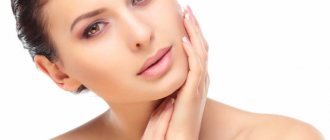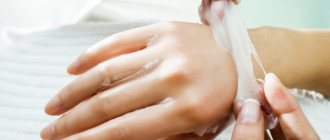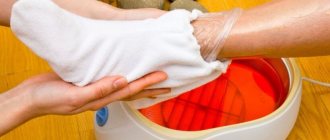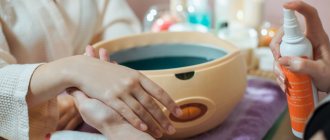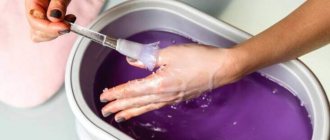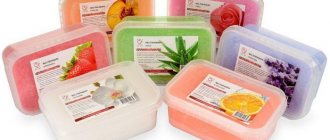Paraffin therapy is one of the few cosmetic procedures, the principle of which remains the same as a hundred years ago. Paraffin-based compresses were in demand in military hospitals during the First World War due to their analgesic and anti-inflammatory properties. Later, the rejuvenating and tonic effect of such compresses was discovered. In beauty salons, paraffin therapy is presented as a care procedure recommended for improving the appearance of the skin and treating dermatological diseases.
Useful properties of paraffin
Paraffin is a heat-intensive, dense substance that reduces its volume as it cools. What are the benefits of this spa treatment for hands and feet:
- Cleanses. The warm substance softens the top layer of skin and opens the pores. After removing the paraffin film, the skin remains deeply cleansed; toxins remain in the paraffin composition.
- Accelerates regeneration. The procedure speeds up metabolism, keeps the skin young and elastic, and slows down the aging process. As it cools, paraffin contracts in volume, acting like a massage.
- Relieves fatigue, relaxes muscles and has a positive effect on the overall condition of the skin.
- Improves lymphatic drainage. The paraffin composition removes waste and toxins, eliminates excess fluid, and relieves swelling.
- Reduces nail fragility, moisturizes cuticles.
Melted paraffin not only has a restorative effect on the skin. As it cools, paraffin transfers heat to the joints. Therefore, the procedure is useful for people suffering from arthritis and arthrosis. The effect of moisturized and soft skin lasts for several days.
Regular hand care can keep your skin smooth and prevent premature wrinkles. To soften the superficial and deeper layers of the dermis and nourish them, you should resort to paraffin therapy, but is it possible to use paraffin several times?
Women who are accustomed to caring for themselves are often interested in whether paraffin can be used several times. Experts assure that this is possible, but only if certain rules are followed.
Paraffin is a mixture of hydrocarbons that has a beneficial effect on the condition of the skin. This drug tends to increase volume when heated. After application to the surface of the dermis, the pores open, blood circulation increases, and fine wrinkles are smoothed out. Paraffin therapy is actively used in hand and body care.
This procedure is quite simple. Paraffin is melted in a special apparatus and applied with a brush to the prepared areas. There are also special baths in which you can heat paraffin and put your hands directly into the container. At home, you can use a water bath to heat the product, but the paraffin must be purified and intended for cosmetic purposes.
After applying wax to your hands, you need to wrap them in film and wrap them in a terry towel. The duration of exposure of the drug to the skin is 20-30 minutes.
After the procedure, the cooled wax is removed from the surface of the skin. Can it be reused? This is quite acceptable when it comes to home care. Some salons also practice re-melting the paraffin, but before doing this, the product must be sterilized at a temperature of 110 degrees Celsius.
Unfortunately, the wax loses some of its properties when reheated and becomes less elastic. Therefore, each time when used paraffin is melted, a portion of a new product must be added to it in the amount of 14 of the total volume. Paraffin can be melted no more than 4 times. After this, it should be completely replaced, as it begins to crumble and further use becomes impossible.
Experts do not recommend going outside for 30 minutes after the procedure. We are talking, rather, about the cold season. Warm gloves can be used to protect softened skin from harmful environmental influences. You cannot apply paraffin to wet hands, since the wax in this case simply will not stick to the skin.
Do not forget about the indications for paraffin therapy. They mainly concern people with circulatory disorders. Paraffin therapy can be performed at home, and in several ways. Experts advise using the layering method. In this case, paraffin is applied in several layers using a special brush directly onto the skin of the hands and arms up to the elbow. You can also apply it to a special base and then apply it to the desired areas. Using a base is also good because in this case it is much more convenient to use the same portion of wax repeatedly. To do this, you just need to separate it from the material and melt it again if necessary.
Cosmetic paraffin can be reused. If we are talking about salon care, it is necessary to sterilize the product before reuse. Also, do not forget to add fresh paraffin to the re-melted paraffin.
Indications and contraindications for paraffin therapy
A paraffin therapy session can be attended for preventive purposes to prevent dryness, flaking of the skin, and the appearance of wrinkles. Or eliminate unpleasant problems that have already appeared - swelling, poor lymph flow, wrinkles, pigmentation, calluses, joint pain. Paraffin wraps are especially useful in the off-season, when the skin on your hands becomes chapped and calluses form on your feet due to tight shoes.
Are there any contraindications to this cosmetic procedure? Yes, they exist, these are:
- high pressure;
- diabetes mellitus;
- phlebeurysm;
- ulcers, wounds, rashes on the hands or feet.
In what media is it found?
Paraffinum liquidum can be found quite often in cosmetics. It is added to:
- creams for hands, face, body and feet;
- sunscreens;
- body milk;
- baby creams;
- baby moisturizing oil;
- hygienic lipsticks, balms and lip pencils;
- Mascara;
- pencils and eye shadow.
You can store such cosmetics in a dry and cool place, away from direct sunlight. The shelf life of such cosmetics is long – from 1 year or more.
How to do paraffin therapy correctly?
This procedure can be carried out at home, but to obtain an effective result, a number of conditions must be met:
- Before the session, apply a cream that does not cause allergic reactions to your skin.
- For this procedure, you can only use special cosmetic paraffin, which when melted does not burn your hands and does not contain harmful components.
- The session is best carried out on special devices equipped with thermostats and temperature indicators.
Attention! Immediately after the session, you should not go out into the cold air, because temperature changes reduce the positive effect.
If you contact the specialists of the OK! Beauty Center, you will save yourself from the need to look for suitable consumables - cosmetic paraffin, gloves, creams, select dishes, and then wash them. Our cosmetologists will carry out the procedure in full compliance with all safety rules; the likelihood of errors due to the unprofessionalism of the masters is completely excluded. We use cosmetic paraffin enriched with plant components and fragrances that enhance the effect of the procedure. The specialist will select the supplements that are most suitable for each visitor.
What are the criticisms of Parrafin in skin care?
Moisture
One criticism of liquid paraffin is that it doesn't actually moisturize the skin. Of course, it's important to strengthen your skin's natural moisture barrier, but many skin care experts suggest that the feeling of moisture created by liquid paraffin is deceiving.
After applying a product containing liquid paraffin, the skin feels soft and silky, which is created by mineral oil, rather than the actual texture of the skin. Therefore, some argue that the moisturizing effect of liquid paraffin is simply a sensory illusion.
While liquid paraffin certainly makes the skin feel soft, the barrier it forms on the skin's surface helps retain moisture. However, it does not improve moisture content directly and will only do so while on the skin, providing short-term benefits for some skin types.
Carcinogenicity
Since liquid paraffin is made from petroleum, many people believe that liquid paraffin is contaminated with 1,4-dioxane. The chemical has been listed as a probable carcinogen by the World Health Organization and the Environmental Protection Agency. However, high demands are placed on liquid paraffin, which is used in the cosmetic and pharmaceutical industries. It must go through numerous stages of purification and testing before it can be used in cosmetics. It must be 99% pure and completely free of chemical contaminants, bacteria and traces of heavy metals. Additionally, according to EWG's Skin Deep Cosmetic Database, paraffin has a Hazard Score of 1, which is the safest rating an ingredient can receive.
Acne
It is believed that liquid paraffin can clog pores and contribute to the development of comedones, acne and pimples. Unfortunately, research on this topic is not conclusive. Liquid paraffin and mineral oil can aggravate existing acne problems. However, the vast majority of people will not experience these problems.
In fact, in a study published in the Journal of Cosmetic Dermatology, cosmetic-grade mineral oil was found to be non-comedogenic, meaning it does not clog pores or cause blackheads and pimples. If you have a history of severe acne, you may want to avoid skin care products with liquid paraffin as a precaution.
Questions and answers
When is it better to do paraffin baths - before or after applying gel polish? Paraffin therapy immediately after a manicure with gel polish is not recommended, since prolonged heat exposure may cause the coating to peel off or crack. Typically, paraffin baths are done before applying gel polish.
Can paraffin be reused? It is not recommended to use an already used composition, since toxic substances pass into it from the skin.
How often can you do paraffin baths? To obtain a lasting positive result, it is recommended to attend 5-10 sessions. The break between them is 5-7 days.
Analogues and alternatives
Despite the active use of paraffinum liquidum in care products, you can always find many cosmetics without this ingredient in the composition. True, manufacturers often replace it with analogues, the same petroleum products, similar in structure and principle of action. Among them:
- mineral oil;
- Vaseline (Vaselinum, Paraffinum unguinosum, Petrolatum) or Vaseline oil.
These components are not natural, but they also have a harmful effect similar to liquid paraffin. Lovers of natural cosmetics should pay attention to vegetable oils:
- peach;
- peanut;
- olive;
- coconut;
- castor and many others.
They increase the cost, reduce shelf life, disrupt the uniformity of the structure of care products, but enrich the skin only with natural ingredients. In any case, what cosmetics to purchase—with or without paraffinum liquidum—is up to the consumer to decide.
Author: Parfeniuk Ihar (iha-rock)
Stages of the procedure
- Remove rings and bracelets from the client's hands. Remove polish or gel polish from your nails (if any) to allow access to paraffin: this material nourishes your nails and makes them stronger.
- Wipe the client's hands with disinfectant.
- Apply scrub to your skin. Using light massage movements, remove dead skin cells, preparing your hands for applying the mask. The scrubs we recommend gently cleanse the skin while deeply nourishing it. Remove any remaining product with a napkin.
- Choose a skin mask depending on your needs. This product plays the most important role in this procedure, since it is from it that the skin will absorb beneficial substances. Almond Illuminating Masque deeply moisturizes, preventing further moisture loss, and gives the skin a healthy tone. Citrus Illuminating Masque has a rejuvenating lifting effect, hiding the signs of aging. Apply the selected mask to your hands.
- Place cosmetic paraffin in the bath and heat it to a temperature of 52-54 °C.
- Ask the client to open her fingers, relax her hand, and gradually immerse it up to the wrist in the heated paraffin. After three seconds, you need to pull your hand out for five seconds and repeat this three or four times until the coat of substance on the hand becomes uniform and dense. Just in case, before diving, check the temperature of the paraffin by smearing it on the back of your wrist. Although if you use baths with a preset temperature setting, there should be no problems.
- Without delay, put a protective plastic bag on the client’s hands. Place thermal mittens over the bag to ensure heat retention.
- After 15 minutes, remove the terry mittens and remove the paraffin layer along with the bag. The movements should go from the wrist towards the fingers.
- Lubricate your hands with cream. The procedure is over.
Paraffin therapy for feet is performed using the same scheme. To carry it out, you will additionally need thermal felt boots.
Therapeutic effect
The main ability of paraffin is to effectively warm tissue. The temperature increases by about 3 degrees. As a result, blood vessels dilate, pores open, blood and lymph supply to tissues improves, and the stratum corneum of the skin softens significantly.
Paraffin has a deep thermal effect, due to which the following processes are observed:
- tissue regeneration is stimulated;
- muscle relaxation;
- analgesic effect;
- improvement of cellular metabolism;
- stimulation of lymph circulation;
- an anti-inflammatory effect is noted.
In addition to the above actions, it is worth noting another important property - the redistribution of liquid, i.e. Through the channels of the lymph flow and bloodstream, the liquid comes out, where paraffin holds it on the surface. Moisture is reabsorbed, effectively moisturizing the skin. As a result, the elasticity of the skin improves, and age-related changes are reduced.
History[edit]
It is said that oil has been used as medicine since 400 BC. E. And was mentioned in the texts of classical authors Herodotus, Plutarch, Dioscorides, Pliny and others. [2] It was widely used by the early Arabs and was important in early Indian medicine. Its first domestic use is attributed to Robert A. Chesebrough, who patented it in 1872 for the production of "a new and useful product from petroleum". [1] After Sir W. Arbuthnot Lane, who was then chief surgeon at Guy's Hospital, recommended it in 1913 for the treatment of intestinal congestion and chronic constipation, liquid paraffin became more popular.



